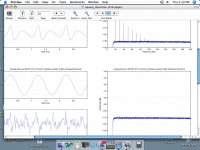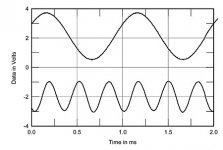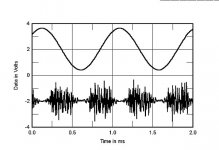SY, what do you want?
Exactly what I asked for- data from preamps run into standard 10k loads comparing a preamp made from a good IC opamp compared with what you consider a "high end" design such as the BT or Parasound. If you don't have it, admit it, and we can dismiss your claims and move on.
It is almost impossible to measure the actual nonlinearity of an AD797 at low levels (typical working levels) because the high negative feedback and the residual noise floor hides it.
I have difficulty believing that your understanding of feedback is that poor.
Grooner uses distortion magnification technique. One should start with something else to explain sonic differences. BT result in Grooner test would be horrible.
Who wrote (i quote):I showed higher order distortion from a typical graph from Samuel Groner's measurements of the AD797
"At higher frequencies (10kHz and up) slew rate is of great importance for low distortion."
Each time you are talking of an OPA, you refer to parts with 20V/µs or less, and complain with high order harmonic distortions. Chose your poison.
JC, if you haven't got the facilities to measure distortion at those levels, why not send your spare Blowtorch to Sam to test and compare against AD797? If you send him your Hirata box too, I'm sure he'll figure out how to work it.SY, what do you want? I showed higher order distortion from a typical graph from Samuel Groner's measurements of the AD797, that has been discussed here before.
Then we will have Hirata and Sam's measurements to back up your MYTH. Much more convincng than telling us ad nauseum how you have been designing supa dupa stuff for a zillion years, ... everyone else is deaf bla bla ...
We'll leave Quan for a later date when we have more details of how he does his test. Of course you could speed things up by sending Blowtorch to Quan too.
Not at all ... 😀What you appear to be seeking, Fas42, is the equivalent of an old Cadillac sort of design, or pure listening comfort, no matter what. This is a good direction, but it is not my direction in audio design. I want a revealing and clear, effortless design, not a super smooth design. I want the edges to show, and the hidden qualities of a recording to come out in an astounding way. That is different from your path.
I'm not interested in super smooth, I'm interested in intense sound - you know, like the real thing! I've heard plenty of Cadillac sound, not my cup of tea. Other, supposedly good systems, when playing a "bad" recording just sound LOUD, which is not the same thing as intense.
What is intensity of sound? That, which feels comfortable and quite "normal", until you try and talk to someone at what you feel is a reasonable talking volume, and you realise you can't hear a word being said ...
Frank
But, an "extra" is worth noting: there is sufficient detail in every recording, I repeat, every recording, to mold the sound to whichever way you want it: squeaky clean, edgy to the max, super detailed, super smooth. The information's there to to be used, or discarded as the consumer sees fit, to suit his/her agenda for the sound wanted; in the future I can see DSP components in the chain which will happily have these sort of settings, that will do what is wanted for the moment. And which "setting" is the correct one? All of them, since all they do is change the balance of emphasis on the different elements that are all still part of the "real", the "correct" recording ...
Frank
Frank
Last edited:
OK, I computed the distortion coming from the Blowtorch, based on its rated distortion at output, at the listening levels that I use.
I came out with: 1/1million % 3rd to 1/1000 % third, second slightly higher at lower levels.
Match that!
I came out with: 1/1million % 3rd to 1/1000 % third, second slightly higher at lower levels.
Match that!
I will ask a simple question that I am sure will not end up being such a simple answer as I have found out many times now. The amplifiers and preamps that we are discussing here whether they are from discrete components or IC opamps fairly consistently use GNFB to achieve the extremely low distortion levels. Now I assume that all of these measurements are taken with a fixed resistance as the load to achieve these results. What affect on these distortion products are there when you measure these same circuits with a real live loudspeaker load on the end of the chain. We are always assuming a purely resistive loading when testing these circuits from what I am seeing. While this does give a baseline to compare two or more topologies against each other does this show the real picture? As has been stated many times the amplifier designer and the loudspeaker designer are mostly working in a vacuum and don't see the other side of the equation. Most speakers produce anything but a nice resistive loading on the circuits and many are much worse than that at least in the reactive and resistive loading. Can someone compare a circuits distortion product using a typical speaker vs one where the impedance and inductance curve has been corrected to produce a resistive loading with a conjugate network that corrects for these problems. How much does this affect the distortion levels as measured at the output of the amplifier? I keep thinking that the feedback circuit is designed to correct the loop only in its global network but then we hang this loudspeaker on the outside of the feedback loop and expect that the same circuit is not modulated by the loudspeaker loading and this is one of the large factors affecting sound quality after all the work the circuit designer in a vacuum puts into the design of the circuit. What say anybody on this factor related to distortion and the corruption of the feedback circuit?
I am interested in super smooth - but only when the signal is super smooth. I really don't like amps that smooth out details and sanitize the sound but super smooth is one extreme of reproduction that should be possible.
I'm happy when I can hear super smooth and lots of natural detail also.
I'm happy when I can hear super smooth and lots of natural detail also.
It is not so easy to compare, Kindhorn man. Right now, we are intensely discussing IC's vs discrete in PREAMPS. They almost always have a fixed load, usually mostly resistive turning to capacitive at higher frequencies.
Let's keep loudspeakers out of the immediate discussion, if you will.
Let's keep loudspeakers out of the immediate discussion, if you will.
OF COURSE, mikelm. That is what we usually want, you know, we audiophiles. There are many however who want FORGIVENESS. I first met up with this when I worked as a consultant to HK, some 35 years ago. They wanted FORGIVENESS, and they found somebody else who could give it to them, some guy who I think has come and gone from the audio scene.
OK everyone, I don't usually measure op amps for a living, so I have never used the DISTORTION MAGNIFICATION TECHNIQUE. However, just a look at a distortion waveform at ANY LEVEL can give me an idea of the circuits performance. Virtually all IC's have a 'kinky' distortion waveform. That means higher order harmonics, because they make the KINKS in the distortion waveform. If it is ALL lower order, you see only a sine wave or two sine waves mixed together, no kinks!
Well, I'm into 'kinky' sound, as well as in other things -- anyone else so inclined ....? 😉, 😀Virtually all IC's have a 'kinky' distortion waveform.
Frank
OK everyone, I don't usually measure op amps for a living, so I have never used the DISTORTION MAGNIFICATION TECHNIQUE. However, just a look at a distortion waveform at ANY LEVEL can give me an idea of the circuits performance. Virtually all IC's have a 'kinky' distortion waveform. That means higher order harmonics, because they make the KINKS in the distortion waveform. If it is ALL lower order, you see only a sine wave or two sine waves mixed together, no kinks!
Just like this vs. this...
Attachments
OK, I computed the distortion coming from the Blowtorch, based on its rated distortion at output, at the listening levels that I use.
I came out with: 1/1million % 3rd to 1/1000 % third, second slightly higher at lower levels.
Match that!
If I get to wave my hands and not measure, not specify output, and not specify load, sure, I can match that.
So, what's the 7th and 9th of the BT? Measured, not computed, and at the same level and load (10k) you would use to rate a preamp using an IC opamp. Or are you ready to say, "I don't have any data to support my assertion"?
Is the AD797 the opamp to beat? Sounds like a very good test to try. I will see if any AD797's are laying about.
This is where the industry comes a cropper, over and over again: the "best of the best" are hooked together, and it impresses no-one ... because, it doesn't "sound right". Meaning: a real life, actual system, working in a typical domestic environment with all its attendant interference and other non-perfect operating environmental aspects, is virtually never tested as a complete entity, using a decent methodology. So, it sorta works, until the user tires of its "sound" and starts playing with options ...I will ask a simple question that I am sure will not end up being such a simple answer as I have found out many times now. ...
Personally, I agree with you 100%: the only thing that makes sense is to measure with all the real bits in place, a complete system, working as a whole.
If you had to choose between buying 2 cars, one where the motor, suspension, braking and body engineers worked in isolation, swore blind that they had created "perfect" components, and all the buyer had to do was bolt them together ... and another, the normal one(!), where examples of finished vehicles are taken out and thrashed in desert, icy and bad road environments, with measurements, 😉 -- which one would you select for everyday use over the next few years ...?
Frank
Last edited:
This is not a useful test. We KNOW that the AD797 measures very, very good, with static distortion. Slew rate should be adequate as well.
If any and everyone of you wants to use an AD797 as a line amp, be my guest.
I personally would use an AD825, myself, and use the AD797's in my test equipment.
If any and everyone of you wants to use an AD797 as a line amp, be my guest.
I personally would use an AD825, myself, and use the AD797's in my test equipment.
- Status
- Not open for further replies.
- Home
- Member Areas
- The Lounge
- John Curl's Blowtorch preamplifier part II


